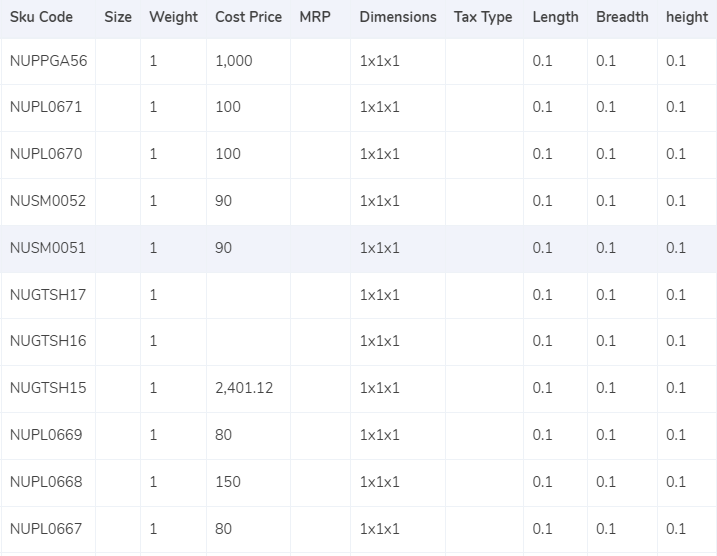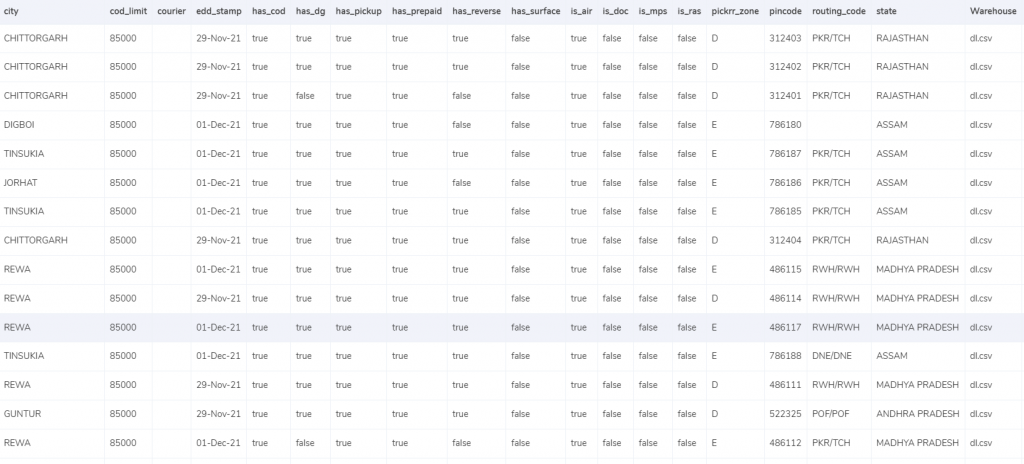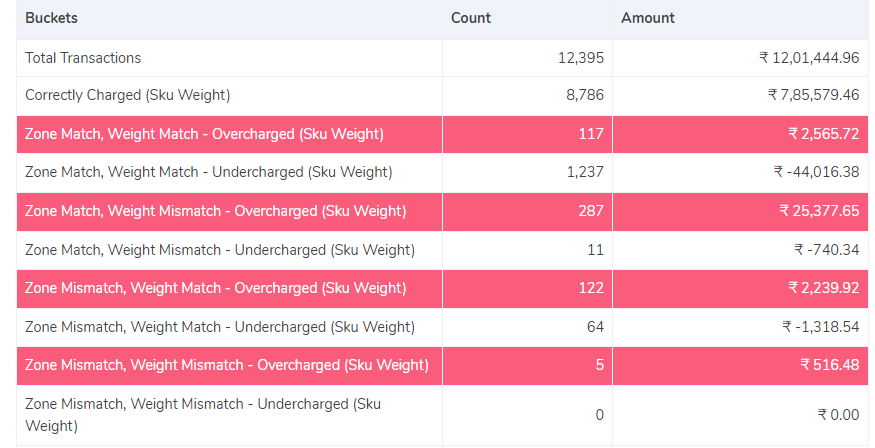Blue Dart is a logistics company. It provides express courier services to companies and individuals. Generally, when companies want to focus on their core competencies and not worry about managing deliveries, they try outsourcing. Blue Dart is one of those courier service companies that are used for outsourcing deliveries. Most companies completely rely on Blue Dart for deliveries as it is a very trusted courier partner. Blue Dart not only carries out domestic deliveries but is also available for international deliveries. It allows customers to track the orders till it reaches the destination. So as you see companies can skip dealing with multiple courier partners and just use Blue Dart.
However, Blue Dart charges a fee on each and every delivery. The fee is based on weight, zone and rate on every order delivered. Since there are many aspects to fee calculation and thousands of orders delivered every day. It is really tough for a company to verify if the right amount is charged every month for all the orders.
Hence, Cointab can verify all those charges on all those orders for the company. The company can view the final result produced by Cointab which clearly shows all the charges and if any amount is overcharged or undercharged.
Required Reports for Blue Dart Invoice Verification Process
Pin Zone Report
It is a record of the Pincode of every delivery of the company
SKU Report
It is a record of the weight and dimensions of every delivery.
Rate Card
It is a record of the charges applicable and the period of its validity.
Blue Dart Invoice
It contains all information regarding weight, zone and rate applied for billing plus the final amounts charged.
INVOICE VERIFICATION
To begin the verification process, Cointab first verifies if the weight, zone and rates are correct and then uses it, to calculate the final fees charged. It is necessary to verify the weight, zone and rates applied by Blue Dart to calculate the billing amount if any of the base figures are wrong then the final amount differs largely. Let’s look at the calculations separately.
Weight

- Here the software goes through a certain procedure to arrive at the expected weight.
- When the dimensions are not present in the report, the software considers the gross weight the expected weight
- To arrive at the volumetric weight the dimensions are multiplied together like the given formula “Length x Width x Height”
- The volumetric weight is divided by the divisor given in the rate card.
- The final weight is finally arrived at
- The final weight is lastly rounded off to get the final slab.
Zone

- The zone is found by the software by looking at the Pincode of the delivery location.
- It is then distinguished locally, nationally etc by giving A, B, and C as the categories.
Rate Card

- To calculate the final fee, the zone, weight and the rates from the rate cards are used.
- The rates are different for the different orders that are Forward or RTO.
- The courier, zone and rate charged on the different weights and types of orders along with the dates till which the rates are applicable are checked by the software to arrive at the right final amount
Charges

Expected forward charges:
The “fwd_fixed” given in the rate card is the rate used when the final slab is below or equal to the weight limit “fwd_wt_fixed”. If the weight exceeds the value given then the rate charged is according to the “fwd” column. Finally, to get the expected forward charge the formula used is
Expected_fwd_chg = fwd_fixed + (extra_weight) x fwd
Expected RTO charges:
The “rto_fixed” given in the rate card is the rate used when the final slab is below or equal to the weight limit “rto_wt_fixed. If the weight exceeds the value given then the rate charged is according to the “rto” column. Finally, to get the expected forward charge the formula used is
Expected_rto_chg = rto_fixed + (extra_weight) x rto
Expected COD charges:
Both the amounts are looked at that is the “cod_fixed” and the “cod_rate” and the greater amount is used as the expected COD charge
Expected GST:
The expected forward charge, the expected RTO charge and the expected COD charges are added. GST % is charged on the sum of those charges.
Expected Final Amount:
The expected forward charge, expected RTO charge, expected COD charge and expected GST is added to get the final amount
RESULT
Once the software makes the necessary calculations and arrives at the expected forward charge, expected RTO charge, expected COD charge, expected GST and the final amount, it produces a result table. The result table is produced only after verifying the calculated amounts with the amount used by Blue Dart.
Order Management System

Found in Unicommerce
The OMS report is used in verification as the number of items delivered is recorded. This helps to verify the weight of the product against the weight used by Blue Dart for billing. This row shows the orders present in the OMS report and the Blue Dart report.
Not Found in Unicommerce
The OMS report is used in verification as the number of items delivered is recorded. This helps to verify the weight of the product against the weight used by Blue Dart for billing. This row shows the orders that are not present in the OMS report but are found in the Blue Dart report.
Pin Code

Found in Pincode Master
The fees are charged according to the zone category. Hence this column is important as it helps see the Pin codes of which zones can be verified. These zones are found in the Pincode master so they can be verified.
Not Found in Pincode Master
The fees are charged according to the zone category. Hence this column is important as it helps see the Pin codes of which zones can be verified. These zones are not found in the Pincode master so they cannot be verified.
Rate Card

Found in Rate Card
Here the order present in the rate card is shown. This helps verify the rates to be charged on the order deliveries.
Not Found in Rate Card
Here the order present in the rate card is shown. This helps verify the rates to be charged on the order deliveries.
Fee Verification using OMS – Blue Dart

Correctly Charged
When the orders match in the OMS report and the Blue Dart invoice report and the zone and weight were also right and the rate charged is also found right after verifying. It means the amount charged is correct.
Zone Match Weight Match – Overcharged
First, the OMS report and the Blue Dart report are compared by the software. Then the software verifies the zone, weight and rate. When the rate used is wrong, it causes the charging of an extra amount, which is then displayed here.
Zone Match Weight Match – Undercharged
First, the OMS report and the Blue Dart report are compared by the software. Then the software verifies the zone, weight and rate. When the rate used by Blue Dart is wrong, it causes the charging of a lesser amount, which is then displayed here.
Zone Mismatch Weight Match – Overcharged
The OMS report and the Blue Dart report are compared by the software. Then the software verifies the zone, weight and rate. When the Zone used by Blue Dart is wrong, it causes the charging of more than the calculated amount, which is then displayed here.
Zone Mismatch Weight Match – Undercharged
The OMS report and the Blue Dart report are compared by the software. Then the software verifies the zone, weight and rate. When the Zone used by Blue Dart is wrong, it causes the charging of lesser than the calculated amount, which is then displayed here.
Zone Match Weight Mismatch – Overcharged
Here, the OMS report and the Blue Dart report are compared by the software. Then the software verifies the zone, weight and rate. When the weight used by Blue Dart is wrong, it causes overcharging. These orders are displayed here.
Zone Match Weight Mismatch – Undercharged
Here, the OMS report and the Blue Dart report are compared by the software. Then the software verifies the zone, weight and rate. When the weight used by Blue Dart is wrong, it causes undercharging. These orders are displayed here.
Zone Mismatch Weight Mismatch – Overcharged
First, the OMS report and the Blue Dart report are compared by the software. Then the software verifies the zone, weight and rate. When the zone and weight used by Blue Dart are wrong, it causes the charging of extra amount, which is then displayed here.
Zone Mismatch Weight Mismatch – Undercharged
First, the OMS report and the Blue Dart report are compared by the software. Then the software verifies the zone, weight and rate. When the zone and weight used by Blue Dart are wrong, it causes the charging of a lesser amount, which is then displayed here.
Invoice Verification using values given by Blue Dart

Correctly charged (BlueDart)
Here using the weight, zone and rate given by BlueDart, the software compares and finds out that the final amount charged is right. So those orders are shown here.
Overcharged (BlueDart)
Here using the weight, zone and rate given by BlueDart, the software compares and finds out that the final amount charged is more than the expected amount. So those orders are shown here.
Undercharged (BlueDart)
Here using the weight, zone and rate given by BlueDart, the software compares and finds out that the final amount charged is more than the expected amount. So those orders are shown here.
Verification of All Charges

Total Orders
The total amount of orders delivered by Blue Dart compared with the OMS report is displayed here.
Total Forward Charges
As shown above, orders below the weight limit have a certain rate and orders with excess weight have a different charge. So, all the forward orders using the respective charges on the orders are summed up to arrive at the expected forward charge.
Total COD Charges
As shown above, COD orders are either charged a fixed rate or a percentage of the product price whichever is higher is used to arrive at the expected COD charges.
Total RTO Charges
As shown above, orders below the weight limit have a certain rate and orders with excess weight have a different charge. So, all the RTO orders using the respective charges on the orders are summed up to arrive at the expected RTO charge.
As seen above the output produced by Cointab displays the necessary information that is needed for fee verification. It shows if the base elements are correct. If incorrect it shows the amount that is undercharged or overcharged due to that.
So, as you can see Cointab makes the fee verification process super easy for the business, so do try Cointab!
Click on the link below to view more from Blue Dart
Blue Dart Courier COD Amount Verification
Click on the links below to view other Courier Charges Invoice Verification
Shiprocket Courier Charges Invoice Verification
Pickrr Courier Charges Invoice Verification
IThink Courier Charges Invoice Verification